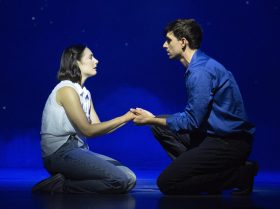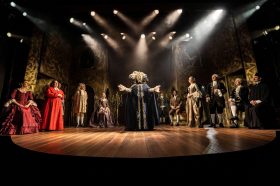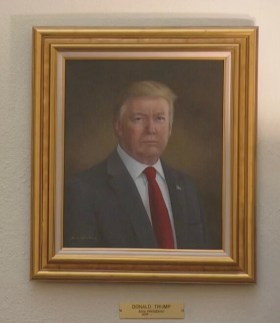As a culture, it seems our fascination with dance – a performance art form that communicates through the body and movement – is one that has grown exponentially in the United Kingdom over the last few decades.
According to Dance UK, an organization founded in 1982 in direct response to the demand from various sectors of the dance community for the creation of ‘a unified voice to speak and take action on its behalf’, the dance industry contained within our shores employs around 30,000 individuals in a myriad of roles, in the likes of dancers, teachers and choreographers, just to name a few.
In 1969 to 1970 the Arts Council Of England supported a mere seven dance companies and organizations – a number which by 1998 had jumped to a respectable 74. In 1999, Dance UK notes that there were an ‘estimated 1472 dance performances held in theatres around the United Kingdom with estimated revenue from these events reaching over 20 million pounds.
In the same time frame the arts councils of England, Scotland, Northern Ireland and Wales contributed a staggering 54 million pounds to the growing dance industry – an obvious testament to the rise in public interest for this universal form of expression.
British choreographers and dancers are known around the globe as being amongst the most challenging and innovative. Renowned companies such The Royal Ballet and The English National Ballet consistently present to the dance loving public classical dance productions of the highest caliber.
So to, artists such as Matthew Bourne, who, with his groundbreaking productions of The Nutcracker and the recently closed Swan Lake to name but two have redefined the way modern British audiences relate to and understand the phenomenon of dance.
For many of us though, the basis of our experience with the world of dance comes primarily from what we see on either the television or movie screens. The historical connection between the art forms of dance and film is a long and often glorious one.
From the early days of Ginger Rogers and Fred Astaire cutting a rug in such film classics as Flying Down to Rio and The Gay Divorcee to more modern fare along the lines of Flashdance, Dirty Dancing and the ever popular Billy Elliot, the symbiosis of dance and film has likewise proven to be an irresistible combination for modern audiences.
So too, in the ubiquitous music video, that mainstay of popular music culture, modern audiences have been exposed to dazzling displays of choreography and showmanship that have characterized what many consider to be ‘proper dance’. Think Michael Jackson with his now iconic 80’s dance routines in the pop video for hits such as Thriller. This is a significant indicator of how truly influential the synergy between dance and film has been in shaping our views on what ‘dance’ as an art form is all about.
Some might forcefully argue that in the case of the former, what we are seeing is merely the Hollywood engine at work utilizing certain forms of dance expression as a tool to prop up an often weak cinematic narrative with the flash and dazzle of a few well executed high kicks and twirls. Or in the case of music video, an investment in an artist and their music with the primary aim of selling a million cd singles to a voracious teen market that slavishly follows music and fashion trends made popular on both the big and small screens.
The argument that dance as a medium is only truly effective when viewed live – and that cinematic representations of the artform are merely dance’s poorer cousin –albeit a glossily attired one – are all too familiar. Many however would beg to differ, and no doubt Carol Straker, Chief Executive of the Constellation Change Screen Dance Festival ,which high kicks into action on the 16th of March would be amongst these.
Currently in its seventh year, the festival was first launched in 1998 to celebrate the tenth anniversary of the Carol Straker Dance Company, one of the UK’s most distinguished dance institutions. To commemorate the occasion , the film Constellation Change was created. This celluloid homage to the stars and repertoire of the company was a piece that went on to win great acclaim with both film and dance aficionados and subsequently took the prize for best documentary at the prestigious Du Pre Awards held in France.
Since its beginning, the festival has gone on to become a truly international event. Bringing, as it has, to the British arts-loving public over ‘800 film submissions since 2001’ proudly showcasing outstanding works from over 47 different countries from around the globe.
The 2005 festival looks to be amongst the best yet, with a dazzling array of very different works that beautifully highlight the diversity that is at the very heart of dance as an art form. In its feature film section, one of the festival highlights will undoubtedly be the European premiere of Dance Cuba ;Dreams Of Flight a feature film ‘focusing on the historic collaboration between dance companies from Cuba and America’. Intertwining personal stories from the likes of Alicia Alonso, the 80 year old icon of Cuban ballet and the founder of the Ballet Nacional De Cuba and world renowned Carlos Acosta, the film brings to life the personal stories of those who have managed to combine both their love of dance and family together in an often highly charged political environment. As an added highlight, the screening will be followed by a Q & A session with the films director Cynthia Newport.
Another festival highlight will undoubtedly be Anything But Love a glossy homage to ‘1950’s technicolour musicals given a distinctly contemporary cinematic feel. Written by and starring the talented Isabel Rose it tells the story of cabaret singer Billie Golden who aspires to greater things than eking out a career in dingy airport lounges through the use of skillful dance and dazzling choreography.
In its short film categories, Dance, Camera, Action 1,2 & 3 the festival also offers something for every dance lover. Highlights include the surreal Distemper, a five minute piece detailing ‘the nightmare of suffocation’ from renowned Canadian troupe Decidedly Jazz Danceworks. The Wedding is a short piece portraying the ‘emotional arc of a woman’s life through a unique combination of dance, drama and the music of Joni Mitchell’ and Bailaores is an Italian submission highlighting an attempt by four contemporary dance artists ‘to break down the boundaries of flamenco dance and make it a universal art form’.
World renowned dancer and choreographer Martha Graham once commented that ‘…the instrument through which the dance speaks is also the instrument through which life is lived, the human body’. Through adding to this equation the unquestionably universal power of the cinema screen through celebrations such as the Constellation Change Screen Dance Festival, the art form that is dance will undoubtedly continue to reaffirm its well deserved place in the pantheon of the immortal arts.
Visit the following website for more information:
www.constellation-change.co.uk/
www.danceuk.org/




